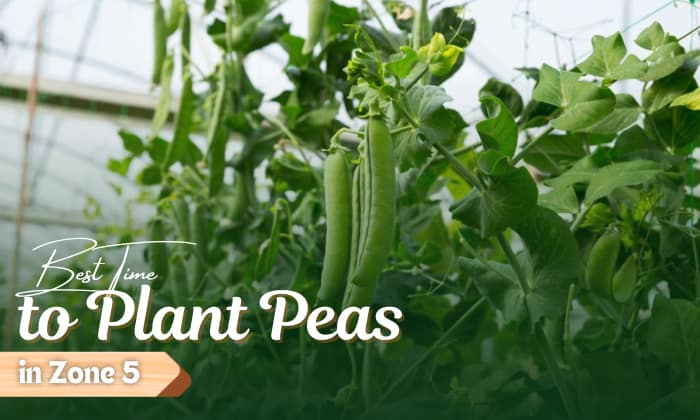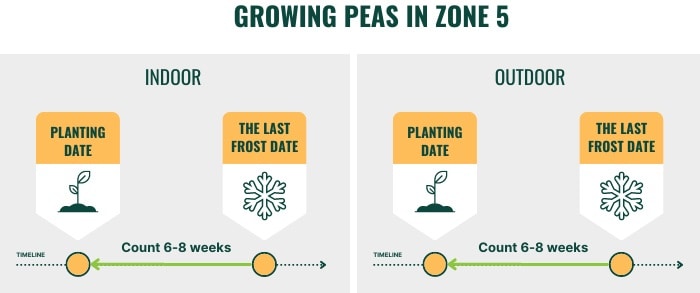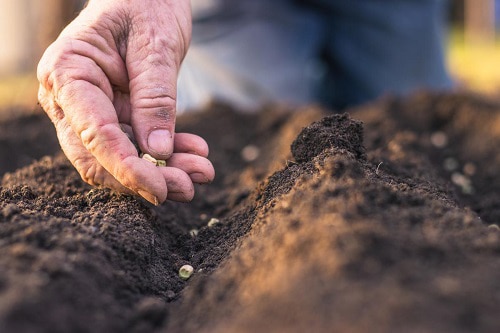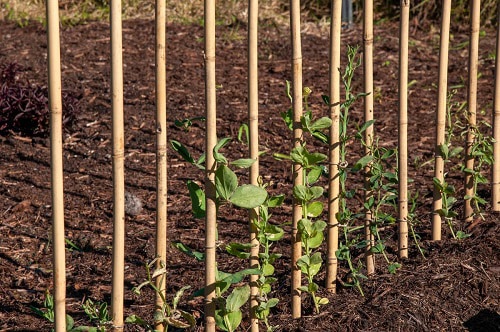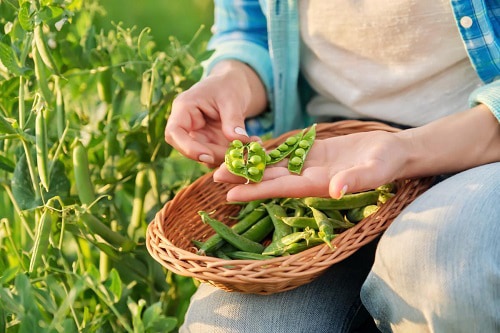As cool-weather crops, peas adapt well to the climate of lower hardiness regions like zone 5. If you’re contemplating when to plant peas in zone 5, the growing season here is either spring or fall.
Growers should sow seeds from March 20 to mid-May or from July 2 to August 6 for the best results.
Read below for more tips on cultivating these legumes.
Table of Contents
Best Time to Plant Peas in Zone 5
1. Plant in the spring from March to May
When it comes to spring planting times for zone 5, you can start pea seeds either indoors or outside.
- For indoor planting, six to eight weeks before the last frost is a good guideline to adhere to.
- But if you want to direct-sow outside instead, wait until there are four to six weeks left before the final spring frost to start planting. In this scenario, the soil should measure 45 degrees at the minimum and feel loose and not soggy.
It’s vital to note that peas don’t transplant well, so you should put them in biodegradable containers and wait until the seedlings have developed true leaves before moving them. Typically, it would be four weeks after indoor seeding when transplanting is possible.
Because zone 5’s average last frost is May 15, zone 5a and zone 5b planting schedule is as follows:
- Grow peas in pots indoors – March 20 – April 3
- Transplant peas outside – April 17 – May 1
- Start peas outdoors – April 3 – April 17
2. Plant in the fall from July to August
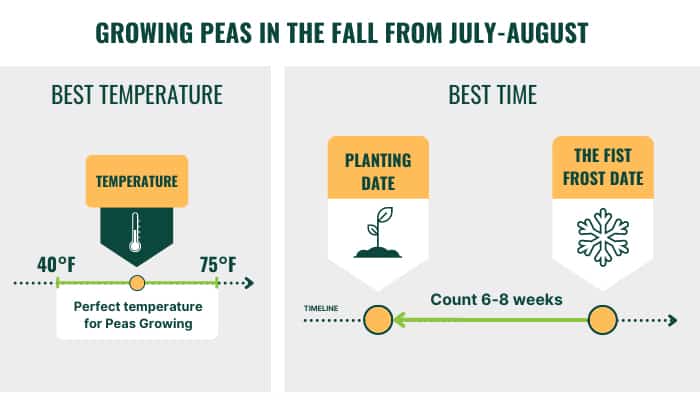
However, you can also plant peas as early as July 1 when the summer heat is not stifling. So long as temperatures measure 40 to 75℉ and do not exceed 85 degrees, your legumes should mature just fine.
In determining the latest date for growing pea plants, add 10 days to the maturation period of your variety (which is often 55 to 70 days), then subtract the result from the first frost date.
Suppose your pea finishes growing in 55 days; 10 days plus 55 days equals 65 days. If your first frost is on October 21, the final planting date would be August 17.
3. Planting time for different areas
Here is the approximate zone 5 gardening time for different localities in the US.
| Place in zone 5 | Spring planting time (indoors) | Spring planting time (outdoors) | Fall peas planting time |
| Anchor Point, Alaska | March 27 | April 10 | July 7 |
| Aspen, Colorado | April 13 | April 27 | July 1 |
| Ainsworth, Nebraska | March 10 | March 24 | July 14 |
| Gardner, Massachusetts | March 13 | March 27 | July 19 |
| Jefferson, Wisconsin | March 6 | March 20 | July 24 |
Pea Planting Guide in Zone 5
1. Selecting the right pea varieties, planting techniques
Some pea varieties you can grow in zone 5 are:
- Sugar Ann – Matures in 56 days, ideal for containers and salads.
- Oregon Sugar Pod – Matures in 64 days, great for freezing and has a crunchy texture.
- Lincoln – Finishes growing in 60 days, sweet and tender with impressive clay soil tolerance.
- Mammoth Melting Sugar – Harvestable 68 days after planting, suitable for fresh consumption and canning.
- Green Arrow – Reaches full maturity in 69 days. High-yield and resistant to downy mildew.
Overall, you can look at seed packages to find a variety’s hardiness zones and know when peas are ready to pick. Early-maturing cultivars like Sugar Ann will be better when planting peas for fall harvest, though all pea crops will handle cold weather well.
Once you’ve got your seeds, follow the steps below to sow them.
- Remove all weeds from the soil and ensure it has a pH of 6 to 7. Dig two inches of compost into the top four inches of the ground, which should receive full sun for optimal growth.
- As for how deep to plant peas, an inch will do for both direct and container sowing. If you do use containers, select those with drain holes and a depth of three to eight Purchase a general-purpose commercial potting mix as well.
- Just as importantly, two inches should be the minimum distance between seeds, while seven inches will suffice for rows.
2. Care for pea plants
Give the soil an inch of water per week when growing peas from seed. Regarding fertilizing, since we’ve already applied compost before planting, it’s unnecessary to incorporate any further amendments.
Some pea varieties, such as bush and pole types, will require staking or trellising due to their extensive heights. With these, you can push bamboo stakes into the soil and tie them to plants with cotton twine to support peas when growing.
3. Harvesting and storing fresh peas
How long does it take for peas to grow? Peas will mature in 55 to 70 or 80 days at most, so mark your calendar to be sure of the harvest date.
You can collect peas three weeks after flowers appear, when the pods are plump for sugar snap and shell peas or once they are three inches long and flat on the outside for snow pea varieties.
Morning is the best time for harvesting peas, and the task consists of pulling the pods off the plant with your hands.
Afterward, store the legumes in a container in the fridge crisper drawer to keep them for a week.
Alternatively, freeze them to preserve the peas for as long as a year. You only need to shell the pods, blanch the peas for 1.5 minutes, then dunk them in ice water for two minutes.
Once these steps are done, freeze the legumes on a baking sheet for an hour before putting them inside a freezer bag.
Related: Best time to plant sugar snap peas for fall harvest.
Frequently Asked Questions
How early can I pick peas?
Follow the tips above to narrow down your harvest date. But if you’re too impatient to wait two months or so to collect peas, it’s possible to pick them earlier as microgreens, when the plants are three to four inches tall and have had eight to fourteen days to grow.
What is zone 5 flower planting schedule?
Here is a short seed starting calendar for flowers in zone 5. Within this planting schedule perennials include black-eyed Susan, lavender, aster, and columbine, while annuals comprise flowers like snapdragon, strawflower, and amaranth.
- March – Grow black-eyed Susan, lavender, aster, columbine, hollyhock, and foxglove indoors.
- April – Sow snapdragon, strawflower, marigold, amaranth, and sunflower indoors.
- May – Direct-sow borage, foxglove, marigold, strawflower, sunflower, and alyssum. Transplant black-eyed Susan, lavender, amaranth, columbine, hollyhock, foxglove, snapdragon, marigold, and sunflower outdoors.
- June – Transplant aster and strawflower outside. Direct-sow amaranth.
Conclusion
Peas are rich in fiber and beneficial for our cardiovascular health. They also have a long shelf life, so it’s possible to grow and have multiple bags of peas fresh and ready for eating whenever you need them.
If you find this article on when to plant peas in zone 5 helpful, please share it with other people. Thanks for reading.

Hi, I am William – Floridayards’ digital content creator. My job is to find answers to all your concerns with thorough research and our team’s expert advice. I will also bring you honest reviews on the best products and equipment for raising your beautiful garden. Please look forward to our work!


